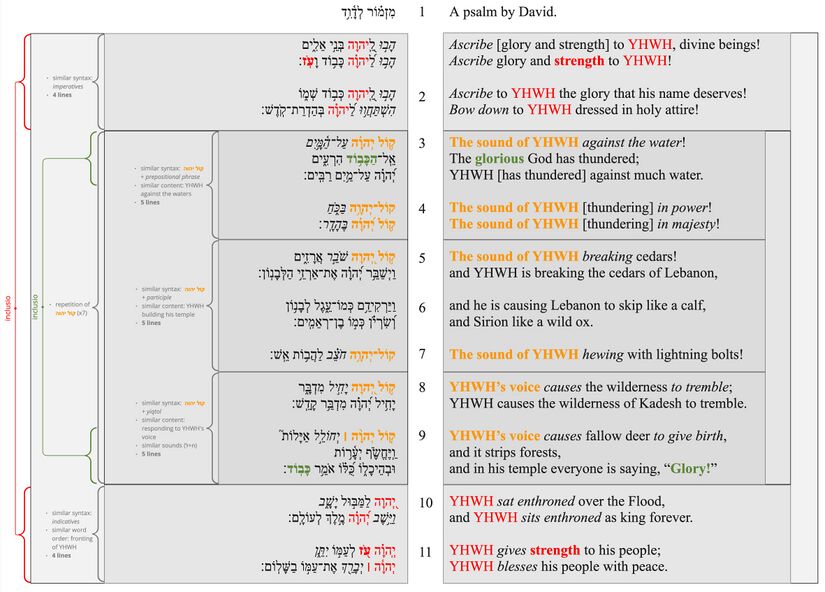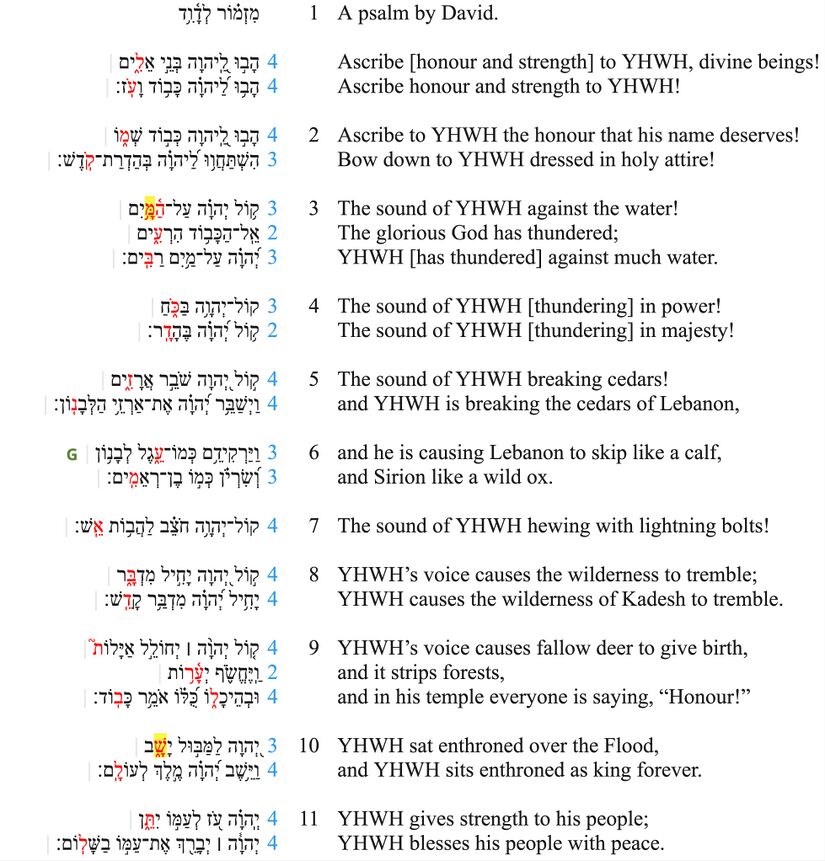Psalm 29 Poetics
Poetic Structure
- The psalm is framed by an inclusio; it begins and ends with four-line unit containing the key term "strength" (עז) and the four-fold mention of YHWH's name.
- vv. 1-2 are bound together by similar syntax (imperatives).
- vv. 3-9 are bound together by the sevenfold repetition of the phrase קול יהוה. This large unit is also framed by an inclusio; it begins and ends with a tricolon that contains the word "glory".
- Within the unit of vv. 3-9, there are three sub-units, each of which is 5 lines long.
- vv. 3-4 are bound together by similar syntax (קול יהוה followed by prepositional phrases) and similar content (description of YHWH's battle against the waters).
- vv. 5-7 are bound together by similar syntax (קול יהוה followed by participles) and similar content (description of YHWH building his temple out of cedar and stone).
- vv. 8-9 are bound together by similar syntax (קול יהוה followed by finite verbs [yiqtols]), similar sounds (ח + ל), and similar content (description of creation responding to YHWH's voice).
- The final section (vv. 10-11) corresponds to the first and is further bound together by similar syntax (indicative verbs) and word order (fronting of YHWH).
Top Poetic Features
(video link)
1. Thunder
Feature
The phrase קוֹל יְהוָה appears seven times in this psalm (vv. 3a, 4ab, 5a, 7, 8a, 9a). The word קוֹל can refer to thunder (pl. קֹלֹות in Ex. 9:23, 29, 33f; 19:16; 20:18; 1 Sam 12:17f; sg. קוֹל associated with "thunder" [רעם] in 1 Sam 7:10; Isa. 29:6; Ps. 18:14=2 Sam. 22:14; Ps. 77:19; 104:7; Job 37:4). In Ps. 29, this association with thunder is made explicit; the first appearance of the phrase in v. 3a is followed by "the glorious God has thundered" (v. 3b). Other verses in the psalm allude to thunder (e.g., "lightning" in v. 7; deer giving birth in v. 9).
Effect
The use of קוֹל יְהוָה has structural effect, binding vv. 3-9 together as the body of the psalm, framed by an introduction (vv. 1-2) and conclusion (vv. 10-11). The seven-fold repetition of קוֹל יְהוָה (lit.: "the sound of YHWH" or "the voice of YHWH") also sounds like seven peals of thunder booming throughout the psalm (cf. Rev. 10:4). The feature may also have a polemical effect. The Canaanite god Baal was associated with thunder. E.g., "Ba'lu emits his holy voice, Ba'lu makes the thunder roll over and over again. His [holy] voice [causes] the earth [to tremble], [at his thunder] the mountains shake with fear" (COS I:262-263). Another text associates Baal's lightning and thunder with the number seven: "Seven lightnings (he had), Eight storehouses of thunder were the shafts of (his) lightnings" (RS 24.245 lines 3b-4). The seven thunders of YHWH in Ps. 29 demonstrate his superiority over Baal.[1]
2. Glory & Strength
Feature
The body of the psalm (vv. 3-9) is framed by four lines on either side of it (vv. 1-2; vv. 10-11). In both vv. 1-2 and vv. 10-11, the name "YHWH" appears four times (once in each line), and the word "strength" (עֹז) appears once. In the first verse of the psalm (v. 1), the divine beings are summoned to "ascribe (lit.: 'give' יהב)... strength to YHWH." In the last verse of the psalm (v. 11), YHWH is said to "give (נתן) strength to his people." Within this frame around vv. 3-9 is another smaller frame: v. 3 is a tricolon with the word "glory" (כבוד), and v. 9 is a tricolon with the word "glory" (כבוד). The psalm thus begins and ends with the giving of "strength," and the central section (vv. 3-9) begins and ends with "glory."
Effect
The fact that the words "strength" and "glory" frame the poem and the central section of the poem suggests that the poem is about "glory and strength." Verses 3-9 may be summarised as a demonstration of YHWH's glory and strength. The introduction (vv. 1-2) and conclusion (vv. 10-11) draw out the implications of YHWH's glory and strength. Because YHWH is glorious and strong, all other gods ought to worship him (vv. 1-2): "ascribe to YHWH glory and strength. And, because YHWH is glorious and strong, his people, who share in his strength, can rest secure (v. 11).
3. More & More
Feature
Several verses in the psalm (vv. 1-2, 3, 5, 8, 10) exhibit a unique pattern called "staircase parallelism."[2] The pattern appears in its simplest form in vv. 3, 5, 8 – ABC//BCD. The first word of the a-line (ABC) is omitted in the b-line which adds a new word at the end of the line to compensate for the loss and expand the meaning of the verse (BCD). In vv. 1-2 and in v. 10, the pattern is slightly different and more complex. Outside of Ps. 29, this this pattern is especially prominent in the Song of Deborah (Judges 5) and the Song of the Sea (Ex. 15), as well as Ugaritic epics.[3]
Effect
The basic effect of this pattern is "to increase tension in the listener."[4]. In Ps. 29, the pattern also has a structural effect. Each of the five strophes in the psalm opens with some form of this pattern (vv. 1, 3, 5, 8, 10). This is consistent with the fact that elsewhere this pattern appears at the beginning of poems or sections within a poem (e.g., Gen, 49:22; Num. 24:3; Jdg. 5:3, 12; Eccl. 1:2).[5] The pattern may also be associated with a particular genre: that of the victory song (cf. Judges 5; Exodus 15). If so, then the pattern gives psalm 29 a triumphant feel. It may that Ps. 29 functioned at one time as a victory song (cf. Psalm 29 Story behind the Psalm).
Line Divisions
- v. 6. On the division of this verse, see The Grammar of Psalm 29:6.
Line Length
Repeated Roots
- There is a very high degree of lexical repetition in this psalm; 16 words/roots are repeated, and some of these are repeated more than once.
- The word קול ("voice") appears 7 times, each time as part of the phrase קול יהוה.
- Verses 3-9 are distinguished by the sevenfold use of קול; these verses are also bound (inclusio) by occurrences of the word כבוד in v. 3 and v. 9.
- The divine name (YHWH) appears 18 times.
- The name appears 10x within vv. 3-9 (distinguished by repetition of קול)
- The name appears 4x on either side of vv. 3-9; 4x in vv. 1-2 and 4x in vv. 10-11.
- The name appears in every verse except for v. 6.
- Much of the root repetition is short range and takes place in consecutive lines or verses
- יהב (vv. 1ab-2a)
- כבוד (vv. 1b-2a)
- מים (v. 3ac)
- שבר (v. 5ab)
- ארז (v. 5ab)
- לבנון (vv. 5b-6a)
- חיל (vv. 8ab-9a)
- מדבר (v. 9ab)
- ישב (v. 10ab)
- עם (v. 11ab)
- The psalm begins and ends (inclusio) with the giving (יהב / נתן) of עז ("strength") (vv. 1, 11). The divine beings are called to "give" (="ascribe") "strength" to YHWH who "gives" "strength" to his people.






